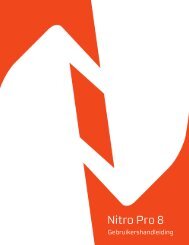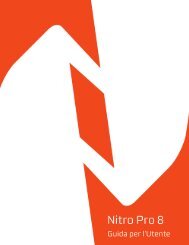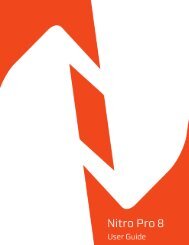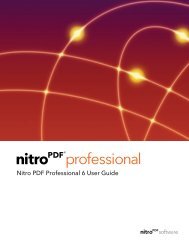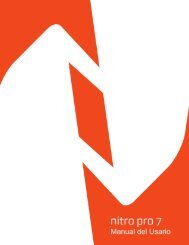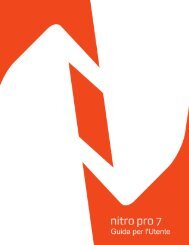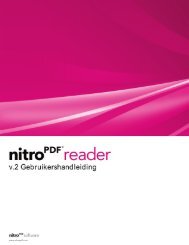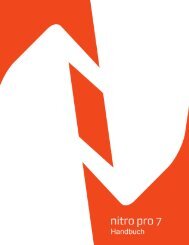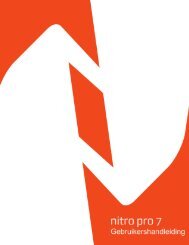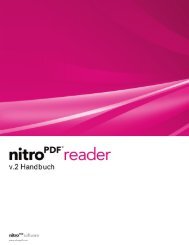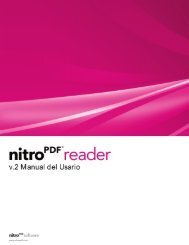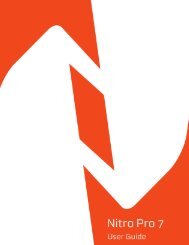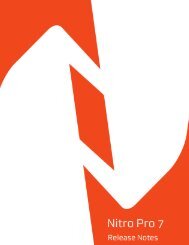Nitro PDF Professional User Guide
Nitro PDF Professional User Guide
Nitro PDF Professional User Guide
You also want an ePaper? Increase the reach of your titles
YUMPU automatically turns print PDFs into web optimized ePapers that Google loves.
topic for more.)<br />
© 2008 <strong>Nitro</strong> <strong>PDF</strong> Software<br />
Forms 71<br />
Tip: When editing form fields, the Edit All Fields tool lets you select and edit any kind of field.<br />
To add a form field:<br />
1. Open the <strong>PDF</strong> in <strong>Nitro</strong> <strong>PDF</strong> <strong>Professional</strong>.<br />
2. On the Form ribbon tab, in the Fields group, click the field type to add.<br />
3. On the page, drag the pointer where you want the field to appear.<br />
To edit a form field:<br />
1. Open the <strong>PDF</strong> in <strong>Nitro</strong> <strong>PDF</strong> <strong>Professional</strong>.<br />
2. On the Form ribbon tab, in the Fields group, do either of the following:<br />
· Click the field type that corresponds to the field you want to edit.<br />
· Click Edit All Fields.<br />
3. Double-click the field to begin editing it.<br />
12.3 Using form field controls<br />
There are seven different form tools. Each tool is used to create the respective field type. To create a field,<br />
first select the tool for the kind of field to be created, and then drag the pointer on the page where you<br />
want to position the field. After creating a field, you can move the field by selecting the respective tool and<br />
dragging it around the page. You can size a field box by dragging any one of the corner handles in or out. If<br />
you need to change field attributes, double-click on the form field to access its properties.<br />
The types of fields you can create in <strong>Nitro</strong> Pro include:<br />
· Push Button . Buttons are used for hyperlinking and invoking actions. You might create a button<br />
to clear data in a form, or to submit form data to a web address or email account.<br />
· Check Box . The attributes for Check Box and Radio Buttons are almost identical. Check Boxes<br />
are used for checking a number of different options such as a grocery list where the user checks all<br />
the items to be purchased at the grocery store.<br />
· Radio Button . Radio Buttons can be used like Check Boxes, but the intent for this field type is<br />
for either/or conditions. For example, you might use radio buttons to identify a credit card type where<br />
only one response is acceptable. As one button is marked, the remaining buttons assigned for a<br />
response to the same question are turned off. All the behavior and conditions assigned to check<br />
boxes and radio buttons are identical. The distinction between the two form field types is the<br />
appearance. Check boxes are square and radio buttons are round shapes.<br />
· Combo Box . Combo Boxes and List Boxes are used when you want to create menus and offer<br />
respondent’s options for selecting choices from a list. The Combo Box uses a down pointing arrow to<br />
open the list.<br />
· List Box . List Boxes are scrollable lists. With Combo Boxes you are limited to assigning a single<br />
response from menu options. List Boxes enable you to assign multiple responses to the menu items.<br />
· Text Field . Text fields are used for respondents to type text in the field box. Text can be either<br />
alpha or numeric values.<br />
· Signature Field . Signature fields are recipients to apply their digital signature to.<br />
12.3.1 Form field attributes<br />
The different types of form fields have some attributes the same, as outlined below, but because the form<br />
fields differ greatly in their design and intent, you have unique attribute assignments you can add to any



